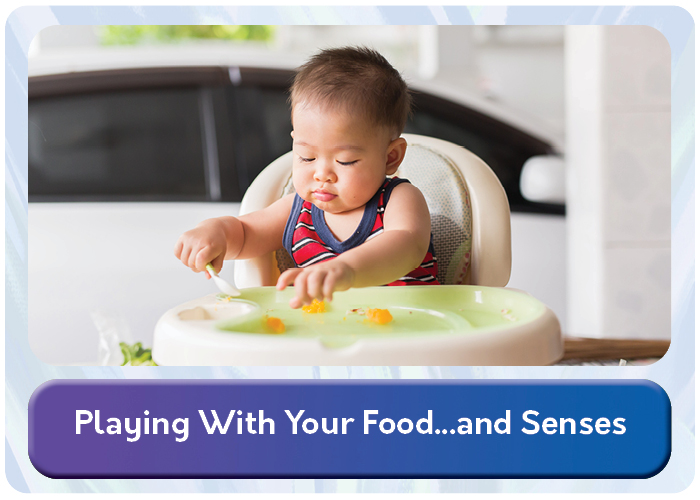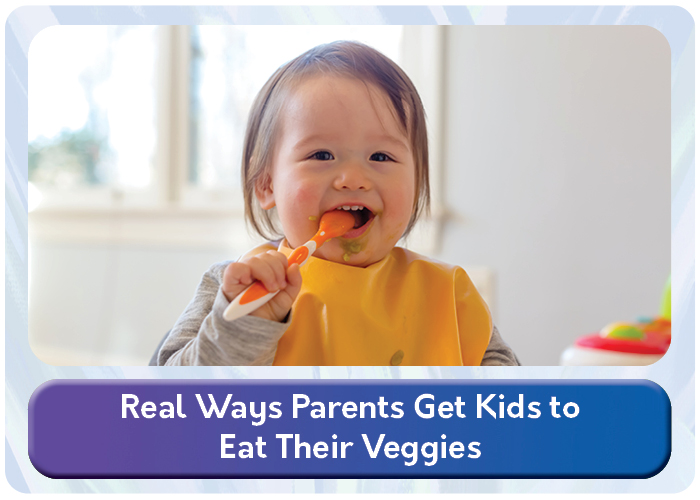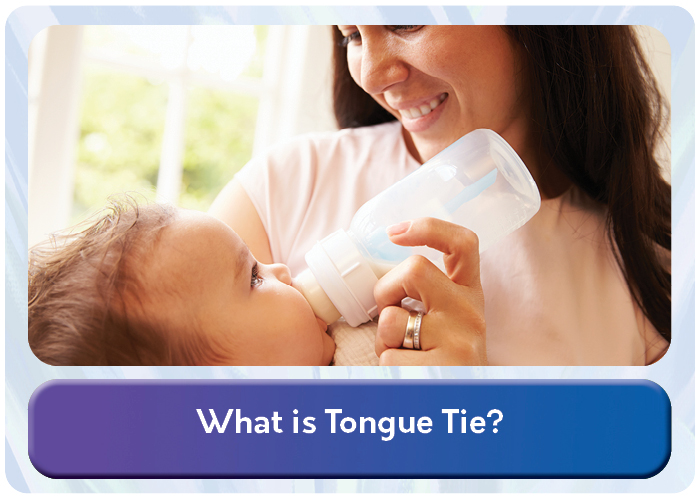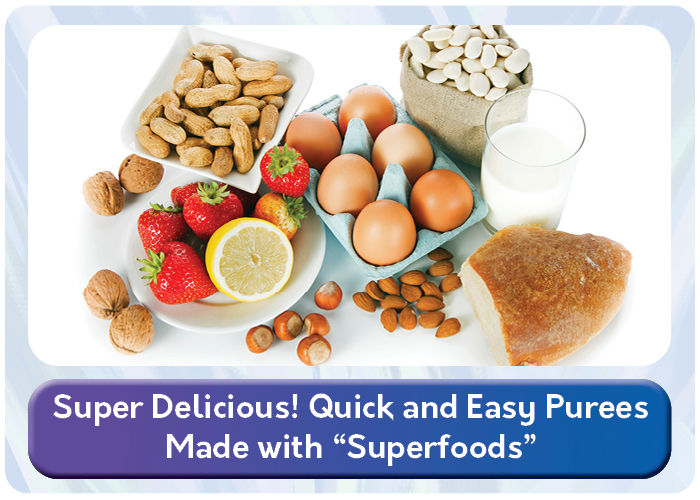Can I Feed My Baby Hatching Lizzard Watermelon and Raw Meat
Feeding: Know the Basics
Every day, baby is growing so quickly! Their growth is powered by skilful nutrition and potent feeding abilities.
Feeding is more just eating and drinking—it helps baby develop the muscles used to chew, swallow, and digest their food. Infant will become through many stages of feeding development, just all of them are important to their growth!
What is feeding?
Feeding looks dissimilar at every age for babies and young children, but it is the intake of nutrition that helps us grow, develop and thrive. About babies begin life past chest or bottle feeding, and slowly build upwards to solid foods.
What exercise stages of feeding look like?
In that location are various feeding milestones baby will meet throughout the offset 18 months. These stages help baby slowly build upwardly to solid foods. Then while they begin by consuming breastmilk or formula, baby typically graduates to purees around 4-6 months, and small solids shortly after.
Learn more about what feeding looks like at 0-3 months, four-6 months, 7-ix months, 10-12 months, and older.
How often should baby feed?
That really depends on the age, but information technology'southward e'er best to attempt and maintain a regular feeding schedule. At a very young historic period, baby feeds often, in smaller quantities. Newborns typically feed every i-iii hours (eight-12 times per day), consuming most 2-3 ounces of breastmilk or formula per feeding. As baby grows, they typically can go longer betwixt feedings.
How do you lot know when your infant is ready for the next stage of feeding?
By post-obit their feeding milestones (see below) and consulting with their healthcare provider. Sensory and motor evolution are of import parts in feeding, and help babe to accomplish the adjacent stage. It's important baby develops the proper muscles needed for chewing, swallowing, and digesting before they can begin thicker liquids and minor solids. Read more about how motor development impacts feeding.
Feeding Milestones
Watch below to learn more than about feeding throughout the 18 months!
0-3 Months
At this age, your infant is but consuming breastmilk or formula—they are not fix for thicker liquids or solids. Newborns oftentimes communicate hunger by showing signs of hunger.
It's also of import to note at this age, baby is not ready for any thicker liquids or solid foods. They too should not beverage cow's milk until they are ane year old.

- Latches onto nipple or bottle
- Natural language moves forwards and back to suck
- Drinks two to 6 oz. of liquid per feeding, 6x per twenty-four hour period
- Sucks and swallows well during feeding

- Breast milk and/or formula

- A newborn's digestive tract and control of muscles of the mouth are still developing, and then they should not be eating whatsoever solid foods
- Babies often explore items by putting them in their mouth. Be aware of choking hazards.
4-6 Months
At this age, infant may exist able to start purees and cereals, every bit long as:
- Baby can sit up in a high chair
- Baby has good caput control
- A healthcare provider has said baby is ready
How practise I transition my baby to solid foods?
- Begin and finish baby's meal with breast milk or formula while they are transitioning to solid foods.
- Alternating between the bottle and spoon tin can help babe connect the idea of spoon-feeding with the condolement of nursing.
What are some proficient foods to start with every bit purees?
Purees are all-time when fabricated with fruits and vegetables that can be cooked, cooled and blended into a shine, thin liquid. Some popular first foods to puree are:
- Carrots
- Apples
- Pears
- Squash
- Green beans
Keep in mind formula or breast milk volition continue to be a cardinal part of their diet until baby is i year old. However, baby should non accept whatever moo-cow's milk until they are 12 months onetime.

- Shows involvement in food
- Opens oral cavity as spoon approaches
- Moves pureed food from front of mouth to back
- Begins to eat baby cereals and pureed foods

- Breast milk and/or formula
- Infant cereal
- Smooth, pureed food (single ingredient only), like carrots, sweet potato, squash, apples, pears

- Bootleg purees should have a thick liquid consistency
- Brand batches of homemade purees and freeze in water ice cube trays. Thaw purees before feeding to your baby.
- Introduce baby to one new nutrient at a time (every 3 days)
- When transitioning to solids, attempt starting and catastrophe the meal with milk/formula
- Having a stronger cadre and more control over their cervix and head move is important for introducing solids
7-nine Months
Every bit baby becomes more than familiar with solids, they can begin transitioning to table foods. This typically happens around eight-9 months.
What types of food tin can I requite babe once they have transitioned to table food?
Give babe a variety of foods that are either mashed or cut into seize with teeth-sized pieces. Different textures and shapes should be provided. A few suggestions for food to requite to baby include:
- Sweet potatoes
- Dark-green beans
- Peas
- Well-cooked pasta
- Soft fruits
Avoid giving baby heavily salted, buttered, or sweetened foods.
Is there anything I should non practice when starting to give infant solid foods?
Do not feed baby solids from a bottle unless their healthcare provider suggests otherwise. This tin drastically increase the amount of nutrient babe eats at each feeding and cause gagging. Learning how to sit up, to utilize utensils, and rest in between bites are good feeding habits to develop.
Sentry for signs infant is gear up for solid foods and tips to brand transitioning to solids easier.
Give baby soft, mashed, or well cooked nutrient that is easy to swallow. Nowadays food in small pieces to preclude choking. Infant should try one new food every three days to help detect potential food allergies.

- In a highchair, holds and drinks from bottle
- Begins to eat thicker pureed and mashed table foods
- Enjoys chew toys that tin massage sore and swollen gums during teething
- Stays full longer subsequently eating
- Starts to look and attain for objects, such as food that is nearby
- Shows strong reaction to new smells and tastes

- Breast milk and/or formula
- Pureed foods
- Yogurt
- Soft, mashed foods similar broiled potatoes or sweet potatoes
- Soft, seize with teeth-sized foods similar:
– Mashed, hardboiled egg yolk
– Small-scale pieces of ripe banana
– Pocket-sized pieces of pasteurized cheese
– Soft breads
– Soft, cooked carrots

- When first introducing thicker purees, mix with a sparse puree
- Vary thinner purees and thicker purees
- Bulk of baby'due south nutrition should still come from breast milk or formula
- Allow your child to play with food and go messy
- Don't feed baby foods with added salt and preservatives
- Alternate giving babe a straw to drink from and helping baby with an open cup
- Endeavour alternate feeding baby with spoon and letting them try to feed themself
10-12 Months
By 12 months, babe tin can begin drinking from an open loving cup. Just recollect, spills happen! Alternate between giving your piddling ane open cups and using straws; this will aid develop different rima oris muscles.

- Finger feeds self
- Eating an increasing variety of food
- Begins to utilise an open up cup
- Ready to endeavor soft-cooked vegetables, soft fruits, and finger foods
- Might be ready to starting time self-feeding with utensils
- Enjoys a greater diversity of smells and tastes

- Chest milk and/or formula
- Couscous, rice, & quinoa
- Additional finger foods:
– Scrambled egg yolk
– Beans/legumes (lentils, black beans, pinto beans)
– Footing meat
– Sliced cafeteria meat cut into small-scale pieces
– Strips of cheese
– Bread, toast, crackers & muffins
– Cooked pasta

- Infant should be eating 3 meals per day plus several healthy snacks
- Use chop option on food processor to serve baby the same meal you are eating at an appropriate consistency or brew with fork
- Serve snacks at consistent times so baby is hungry for meals
- Eat together at the table during mealtimes
13-18 Months
At this age, your toddler is but getting better every day with feeding!
They should be using a cup regularly, and getting used to holding and drinking from a loving cup.
They should too be eating an increasing multifariousness of coarsely chopped table foods.

- Can use open cup independently
- Should exist able to consume virtually foods by one twelvemonth and participate in family mealtime
- Increases diversity of chopped table foods

- With pediatrician's approval, milk is typically introduced at ane year erstwhile
- Fruit cut into small cubes or strips
- Bite-sized, soft, cooked vegetables similar zucchini or broccoli
- Mixed nutrient textures: macaroni and cheese, casseroles
- Finger foods like:
– Small pieces of staff of life/bagel
– Shredded or small pieces of meat/tofu
– Low sugar cereal
– Soft fish

- Encourage self-feeding with utensils
- Remember that your job is to provide healthy, rubber food options to your infant and your baby is in charge of how much to consume
- Mutual choking hazards:
– Hot dogs
– Nuts
– Whole grapes
– Popcorn
– Hard, sticky, gooey processed
Feeding Activities






What to Scout For
Feeding problems and allergies to know virtually
What are the symptoms of nutrient allergies?
If you detect your child has skin bug, such equally rashes, hives, or swelling; stomach problems, such equally nausea, vomiting and diarrhea; and/or breathing problems, these are all symptoms of food allergies. Other signs include stake peel or light-headedness.
What should I do if I recall my child has food allergies?
Talk to your child's healthcare provider. They might recommend allergy testing via a skin prick or claret test or trying a special nutrition to help determine which nutrient is causing the allergies.
Even if your child has no history of allergies, information technology is best to wait three days between new foods. For example, if you innovate your baby to a new food on Monday, don't give them any other new foods until Thursday. In the issue that they do have an allergic reaction, it will exist easier to figure out which food was the crusade.
If it is determined your child has a nutrient allergy, go on your kid abroad from foods containing these ingredients. Make sure to inform your child'south school and any caretakers virtually their allergies or medicines recommended past your child'south healthcare provider to salve symptoms.
What are some common food allergies?
Milk, eggs, peanuts, tree nuts, fish, shellfish, soy, and wheat crusade 90% of food allergies. Introducing one new food every three days can assistance determine if a sure food is causing an allergic reaction.
Source: https://pathways.org/topics-of-development/feeding/
0 Response to "Can I Feed My Baby Hatching Lizzard Watermelon and Raw Meat"
Post a Comment